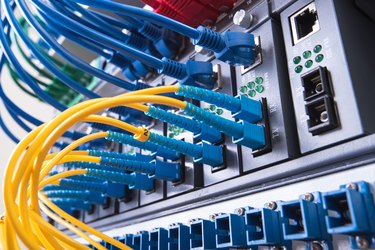
Ethernet refers to a set of standards in computer networking technology. This uniform set of standards facilitates easy communication between diverse equipment such as personal computers, printers and other intermediary devices. As long as a device is compliant to this set of standards, it can be conveniently added to expand an existing network.
A computer network has a logical or data layer (software) and a physical link layer (hardware). In the logical or data layer, the Ethernet standard defines a set of rules called protocols that govern the way machines connected in the network are going to communicate with one another. The physical link layer functions as the path through which the electronic signals will travel. The hardware that handles the physical connections between the machines must conform to particular categories of design in order to become a common medium.
Video of the Day
Video of the Day
The Ethernet cable is one of the essential pieces of equipment in the physical layer of a network. Since new improvements are continuously developed for Ethernet standards, the hardware has also evolved. Older Ethernet set-ups utilized coaxial cables. Current networks use twisted pair or fiber optic cables. The twisted pair cable is so commonly used in Ethernet computer networks that the term "Ethernet cable" has come to directly refer to this particular type of cable.
Structure
The kind of twisted pair cable used for Ethernet is called a Category 5 cable or Cat5. It contains eight individual 24-gauge copper wires grouped into four pairs inside the cable jacket. Each pair is twisted around one another; hence the name "twisted pair." Generally, three twists are applied for every inch of the twisted pair. The actual spacing of the twists is varied per pair. This method of cabling structure reduces the chances of signal interference by external sources such as fluorescent bulbs or radios as well as internal interference or crosstalk from other pairs.
Terminating both ends of a twisted pair cable is an 8P8C connector. 8P8C stands for "8 Position 8 contact." Each wire in a Cat5 cable ends in a pin. The pins are designated numbers 1 to 8 and are similarly paired as the wires. These pins are contact points and are arranged in a row inside the connector's housing. Cat5 cable plugs can only connect to 8P8C sockets that are complementarily structured with eight contact points.
Function
Cat5 cables can be either "straight-through" or "crossover." In a "straight-through" set-up for both plugs and sockets, pins 1 and 2 are used to transmit signals and pins 3 and 6 are for receiving signals. This wiring set-up is used for connecting computers to other network devices such as hubs or switches. In a "crossover" set-up the assignations are reversed so that the transmitting plug pins connect to the receiving socket pins. This is used for connecting computers directly with one another. Cat5 cable sockets can also be set up for internal crossover to receive "straight-through" cables. Newer models of routers, hubs and switches can automatically switch between a "straight-through" and a "crossover" set-up, doing away with the need to use two different Cat5 cables.